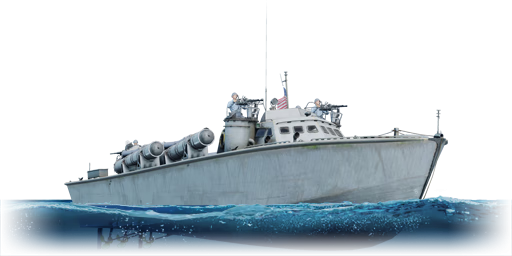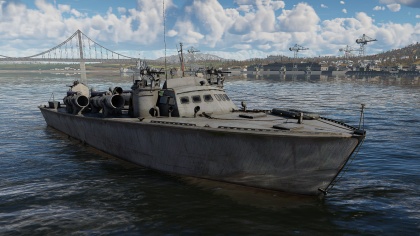Difference between revisions of "PT-71"
(→Pros and cons) (Tag: Visual edit) |
Inceptor57 (talk | contribs) m (→Pros and cons) |
||
| Line 37: | Line 37: | ||
=== Pros and cons === | === Pros and cons === | ||
| − | + | <!--Summarize and briefly evaluate the vehicle in terms of its characteristics and combat effectiveness. Mark its pros and cons in the bulleted list. Try not to use more than 6 points for each of the characteristics. Avoid using categorical definitions such as "bad", "good" and the like - they have a substitution in the form of softer "inadequate", "effective".--> | |
'''Pros:''' | '''Pros:''' | ||
| Line 45: | Line 45: | ||
* Equipped with four torpedoes | * Equipped with four torpedoes | ||
* Decent speed | * Decent speed | ||
| − | |||
| − | |||
'''Cons:''' | '''Cons:''' | ||
Revision as of 21:10, 8 June 2020
Contents
Description
The Higgins 78 ft PT-71 is a rank II American motor torpedo boat
with a battle rating of 2.0 (AB/RB/SB). It was introduced in Update 1.79 "Project X" as part of the fleet closed beta test.
General info
Survivability and armour
Talk about the vehicle's armour. Note the most well-defended and most vulnerable zones, e.g. the ammo magazine. Evaluate the composition of components and assemblies responsible for movement and manoeuvrability. Evaluate the survivability of the primary and secondary armament separately. Don't forget to mention the size of the crew, which plays an important role in fleet mechanics. Tips for preserving survivability should be saved for the "Use in battle" section.
If necessary, use a graphic template to show the most well-protected or most vulnerable points in the armour.
Mobility
Write about the ship’s mobility. Evaluate its power and manoeuvrability, rudder rerouting speed, stopping speed at full tilt, with its maximum forward speed and reverse speed.
Armament
Primary armament
Provide information about the characteristics of the primary armament. Evaluate their efficacy in battle based on their reload speed, ballistics and the capacity of their shells.
Broadly describe the ammunition available for the primary armament, and provide recommendations on how to use it and which ammunition to choose.
Secondary armament
Some ships are fitted with weapons of various calibres. Secondary armament is defined by the weapon chosen with the control Select secondary weapon. Evaluate the secondary armament and give advice on how to use them. Describe the ammunition available for the secondary armament. Provide recommendations on how to use them and which ammunition to choose. Remember that anti-air armament, even heavy calibre weapons, belong in the next section.
Torpedo armament
Many ships are armed with torpedo launchers, and for some vessels such as boats, torpedoes are an extremely important means of defeating an opponent. Evaluate the position of the torpedo launchers, discuss the ammunition available, firing specifics such as dead zones, features of the torpedoes themselves, etc.
Usage in battles
The 78 ft PT-71 is a great vehicle for its BR, owing mostly to its armament, which will make relatively quick work of most opponents you will face. However, its main advantage as opposed to similar boats within the USA's tech tree is the excellent positioning of its primary armament. They benefit from a great vantage point, and can both be fired directly forward, something lacking among American MTBs of Rank I. This is especially helpful for novice players who are still getting used to adjusting fire when shooting to the side. The 20 mm Oerlikon Mk.II also packs a good punch, and, considering its positioning, has a decent field of coverage as well. When playing against other MGBs and MTBs, the best strategy is usually to do away with them before they can you, as you possess no armor whatsoever. Your guns should enough range to do so. When going up against bigger ships, using landforms and zig-zagging are crucial to getting close to your target, which will now have to worry about your four torpedoes coming their way. All in all, the 78 ft PT-71 is a versatile boat that is not lacking in any department except for armor (but this is the standard at the rank), and it is a good boat for those just getting into Naval Battles.
Pros and cons
Pros:
- Good rate of fire as well as damage output
- Guns face no obstructions (other than each other)
- Equipped with four torpedoes
- Decent speed
Cons:
- No armor (though this is standard for the rank)
- The ammunition explodes often in battles due to being large enough to be hit
History
PT-71 was layed down on December 2, 1941 by Higgins Industries, in New Orleans, Louisiana. It was launched on May 4, 1942, and was completed on July 20, 1942. It was commissioned on April 27, 1943 as the USS PT-71, and it was assigned to Motor Torpedo Boat Squadron FOUR (MTBRon 4) under the command of Lt. Comdr. William C. Specht, USN. MTBRon 4 was the training squadron for motor torpedo boat crews, based at MTB Squadrons Training Center, at Melville, Rhode Island.
PT-71 was transferred to Motor Torpedo Boat Squadron SIXTEEN (MTBRon 16) under the command of Lt. Comdr. Russell H. Smith, USN, on January 20, 1943. MTBRon saw action during the Aleutian Campaign.
On March 13, 1943 PT-71 was transferred to Motor Torpedo Boat Squadron SEVENTEEN (MTBRon 17) under the command of Lt. Comdr. Russell B. Allen, USN. MTBRon 17 was assigned to the Hawaiian Sea Frontier. On April 16, 1943 the PT-71 was transferred back to MTBRon 4.
On March 18, 1944 the ship was transferred to Motor Torpedo Boat Squadron TWO - (MTBRon 2) under the command of Comdr. John D. Bulkeley, USN. MTBRon 2 was assigned to the Office of Strategic Services, and was located in the English Channel. Between May and October of 1944 the squadron carried out 20 missions, landing supplies and personnel in enemy occupied territory. On October 11, 1945 PT-71 was struck from the Naval Register. It was stripped and destroyed on October 21, 1945 at Samar, in the Philippines.
PT-71 had a displacement of 56 t, a length of 71 ft, a beam of 20 ft 8 in, and a draft of 5 ft 3 in. It was powered by three 1,500 shp Packard W-14 M2500 gasoline engines, and had three shafts. The armament consisted of four 21" torpedoes, one 40mm mount, and two twin .50 cal. machine guns. The crew complement was 17 sailors and officers, and it had a maximum speed of 40 knots.
Media
An excellent addition to the article will be video guides, as well as screenshots from the game and photos.
See also
Links to the articles on the War Thunder Wiki that you think will be useful for the reader, for example:
- reference to the series of the ship;
- links to approximate analogues of other nations and research trees.
Bibliography
- Radigan, Joseph M. PT-71. NavSource Naval History. http://www.navsource.org/archives/12/05071.htm
External links
Paste links to sources and external resources, such as:
- topic on the official game forum;
- encyclopedia page on ship;
- other literature.
| USA boats | |
|---|---|
| Motor torpedo boats | PT-3 · PT-6 · PT-20 · PT-71 · PT-103 · PT-109 · PT-174 |
| PT-200 · PT-314 · Thunderbolt (PT-556) · PT-565 · PT-658 · PT-810 · PT-811 · PT-812 | |
| Motor gun boats | Kim Qui · LCS(L)(3) · PT-59 · PTF-7 · USS Candid · USS Asheville · USS Douglas · USS Flagstaff · USS Tucumcari · USS Cyclone |
| Armoured gun boats | LCM(6) Zippo |





